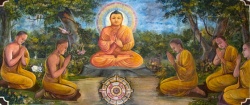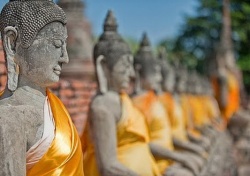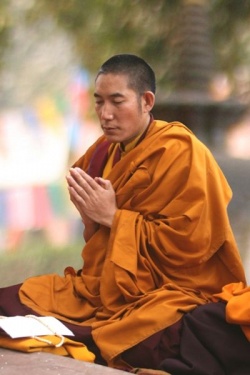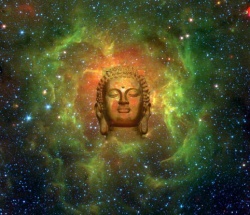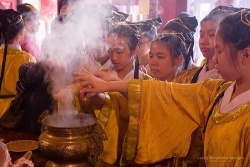Samaya
The samaya (Tibetan: Tibetan: དམ་ཚིག, Wylie: dam tshig, Japanese and Chinese: 三昧耶戒, sanmaya-kai, Sānmóyéjiè), is a set of vows or precepts given to initiates of an esoteric Vajrayana Buddhist order as part of the abhiṣeka (empowerment or initiation) ceremony that creates a bond between the guru and disciple.
According Keown, et al., Samaya may be defined as:
- A particular system of teaching or doctrines;
- The conduct required of a tantric practitioner, often as a set of vows or commitments;
- The realization (abhisamaya) of Buddhahood;
- In Tantric Buddhism, union with the Three Vajras, the body, speech and mind of the Buddha.
Fourteen root downfalls
In one of the most widely followed teachings on samaya, Sakya Pandita, a preeminent 12th century Tibetan Buddhism scholar, outlined fourteen primary points of observance to consider in keeping one's samaya vow "pure". Other outlines however contain three, twenty-eight, or other denominations of points of observance. These may be further divided into root and branch samayas.
These vows pertain specifically to the anuttarayoga tantra class of practices; they are incurred after one has received an abhiṣeka into that class of practices. The fourteen vows described by Sakya Pandita, as elucidated by Shamar Rinpoche, are transgressed by the following fourteen root downfalls (Wyl. rtsa ltung bcu bzhi):
- Physically harming or slandering the teacher from whom one received the abhiṣeka - The following conditions must be present for the samaya to be broken: one must be fully aware of one's actions and intend them, be aware that they will displease the teacher, and fail to regret them. With intention but no follow-through, only a breach is committed. Further, the severity of the breach is considered small, average or great depending on whether or not the student has received abhiṣeka, explanations and pith instructions—if just the former it is small, if the first two it is average, and if all three it is great.
- Opposing the words of the buddhas - Denigrating Buddhist teachings.
- Strong negative emotions towards one’s vajra brothers and sisters - Becoming strongly hostile towards men and women who have received abhiṣeka from the same teachers as oneself
- Abandoning loving kindness and compassion for sentient beings
- Abandoning the bodhichitta in aspiration or application
- Criticizing other Buddhist traditions
- Revealing secrets to those who are unworthy "If one describes the meaning of great bliss as taught in Vajrayana to individuals who do not possess the required educational background, they might misunderstand and abuse these teachings. "
- Mistreating one’s body "The human body is the support for dharma practice, the basis upon which realization of the two buddhakayas is attained. With respect to Vajrayana the human body is considered to be an important instrument on the path. Therefore exposing the body to extreme conditions such as whipping, burning or destroying it by suicide, contributes to the breaking of the samaya."
- Abandoning emptiness
- Keeping bad company Associating with samaya corrupters
- Failing to reflect on emptiness
- Upsetting those who have faith in the teachings
- Failing to observe the samaya commitments "During specific occasions the Vajrayana master, who should be a highly qualified teacher, will require that the student carries out certain practices such as secretly eating the 5 types of meat, drinking the 5 kinds of nectar and dancing nakedly. This is requested in order to test whether or not conventional concepts are relinquished. If, due to moral tendencies, one hesitates or refrains from carrying out these rituals, this contributes to the breaking of the samaya."
- Denigrating women "Within Vajrayana women are considered to be the embodiment of wisdom. Regarding women as inferior or abusing them as witnessed in certain cultures, contributes to the breaking of the samaya."
Shamar Rinpoche states,
- Breaking one or a number of these 14 points requires purification within a short period of time. The most optimal is to purify this difficulty within one day. From among the various practices offered, an effective and simple method concerns the meditation and recitation of Vajrasattva. This practice involves the flow of nectar throughout the body by which all defilements and broken commitments will be purified. Due to conscious and unconscious reasons one often breaks the samayas. It is therefore recommended to apply this practice at least once or twice a day.
Jamgon Kongtrul comments on the Lamrim Yeshe Ningpo that samaya is established by taking abhiṣeka and samaya is the manner in which practitioners "preserve the life-force of that empowerment within your being".
In India people of samaybuddh school worship SAMAY (TIME) as God and Buddha as path teller.
Root and Branch
Khenpo Karthar Rinpoche defines root samayas as any which if violated would remove all the benefit from practicing. He defines branch samayas as any which if violated would diminish or impair the benefit of practice. He states that the most egregious root samaya to violate is the commitment to one's guru.
Foregrounding the mindful observance of the mindstream, whilst intimating the binding reciprocity of samaya, Gyatrul (b.1924) in his commentary to Chagmé (Wylie: karma-chags-med, fl. 17th century), rendered into English by Wallace (Chagmé et al., 1998: p. 29) states:
- If a Lama obstinately refuses to grant instruction to a qualified disciple, this constitutes an infraction of the Lama's samaya. It is proper for the Lama to show some hesitation by not consenting on the first request in order to arouse and examine the disciple. It is not a ploy to see if the amount of offerings can be increased, but rather provides time to examine the student's mind-stream.
In the Nyingma lineage, the three root samayas are categorized as body, speech, and mind. Each requires refraining from non-virtue as well as maintaining sacred view. Maintaining sacred view generally means to view all beings and all phenomenon as 'primordially pure' (Tib: kadak). The samaya of body is to refrain from non-virtue with respect to body, and also to always offer yourself to your guru and to your vajra sangha. The samaya of speech is to avoid non-virtuous speech, and also to never forget one's commitment to practicing mantra. The samaya of mind is to refrain from divulging the secrets and to always maintain the view that one's mind is dharmakaya.
Repairing Damaged Samaya
According to Tulku Urgyen Rinpoche, there are four increasing stages in which one's samaya may be damaged: "infraction, breach, violation, and complete break". Once damaged, samaya may be repaired. But if it is left without repair for more than three years, it is not repairable.
Samaya is easily damaged. Patrul Rinpoche said it is very hard to maintain samaya and used a famous metaphor that maintaining samaya is like keeping a mirror or tile clean that is lifted up into a sand storm; dust settles on it as soon as it is clean and we must continuously clean it. To repair samaya, a practitioner may restore mindfulness and awareness of sacred view; confess the violation to another practitioner that holds samaya; recite the one hundred syllable mantra (Vajrasattva mantra); or use other methods determined by their guru.
Shingon Buddhism
In the esoteric lineage of Japanese Shingon Buddhism, the Samaya precedes the Abhiseka initiation ceremony proper. The initiate undertakes four precepts:
- Never to abandon the True Dharma.
- Never to negate bodhicitta.
- Never to withhold or be selective of Buddhist teachings toward others.
- Never to cause any sentient being any harm.
The first recorded taking of the Samaya precepts at Todaiji temple began in 822 when Kukai performed the Abhiseka ritual before the abdicated emperor, Heizei, and helped to establish Shingon Buddhism as a legitimate school in Japan.
